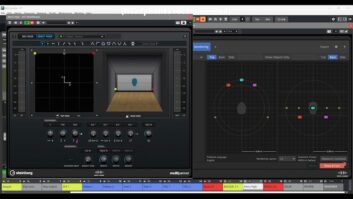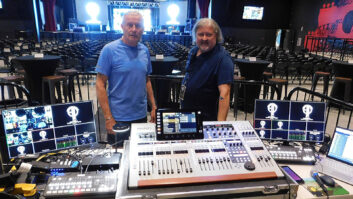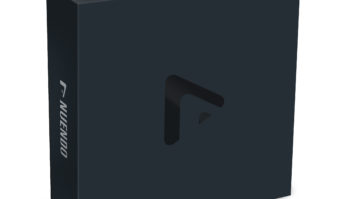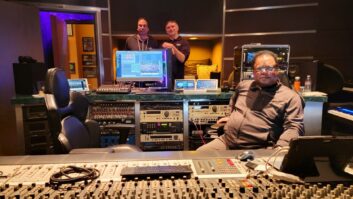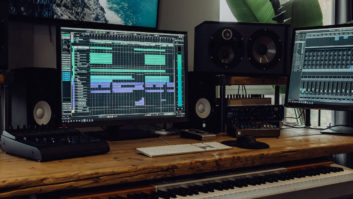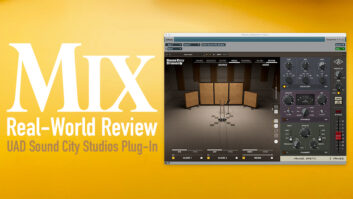
It hardly seems enough to refer to Nuendo 2.0 as simply an “upgrade.” Steinberg’s revision of the powerhouse DAW sports 200 new features and a sleek new look with a feature-rich implementation that supports a bevy of optional add-ons. Nuendo packs format compatibility, user configurability and networking into a powerful and flexible native package.
A RE-ENGINEERED MIXER
Kudos to Steinberg for implementing the feature most requested on the Internet by DAW users: automatic plug-in and channel strip delay compensation for the complete signal path, including groups. You can switch it off in the plug-in information window, but most users will simply breathe a sigh of relief.
Nuendo’s new mixer has the kind of creative flexibility that makes hardware mixers look like…appliances. Gone are the multiple windows for channels, EQ and VST outputs. In their place is a mixer that looks and feels like a mixer. Although it may take a bit of studying to understand the seemingly hieroglyphic notations on the left side, the new mixer gradually reveals itself to be a multilevel digital network that can quickly be expanded for tweaking or collapsed to take up minimal real estate on the screen. In fact, you can create four different mixers, so you can have, for example, one just for FX tweaking, one for MIDI, one for tracking and VST Instruments, and one with just group and folder channels. You can show selected channels and channel strip sections in narrow, wide and extended mixer views.
New multichannel architecture affords 12 channels through every input, audio track, effect return, group and output, with support for mono, stereo, LCRS, 5.1, 6.1, 7.1, 8.0 and 10.2. (More than 20 different surround formats are supported.) Channel sends can have surround panners, and there are now three stereo panning modes: Balance, Dual Pan and Combined Pan. There’s also a handy patch editor for routing plug-in channels inside surround channels. If you want stereo plug-ins routed to the surrounds, it’s a snap to patch them by selecting “e” next to the fader to bring up the VST audio channel settings.
The VST Connections window opens for routing between the ASIO device and all system input/output buses. (Note: Nuendo supports ASIO on the PC and Core Audio on the Mac.) Nuendo 2 includes child buses, or subsets, of multichannel buses. Child buses are part of the parent surround bus, so they do not have separate channel strips, but they can be routed as mono, stereo or other combinations. They are most useful for common routing problems like monitoring a left/right stereo pair within a surround channel on the output bus, but you can also use them on multichannel input buses. You can store and recall bus presets in the pop-up menu at the top of the VST Connections window, so you can have multiple output configurations quickly accessible within the same project. This is great for projects that migrate from the large recording facility to the producer/engineer’s notebook and back.
Nuendo 2 supports an unlimited number of VST Instrument channels, Rewire 2 channels, audio tracks, MIDI tracks (now available as channels in the mixer), groups and effects returns. Realistically, this means that you can have as many as you want until you overload your particular system and performance becomes unstable. Similarly, physical input and output buses are limited only by the restrictions of your ASIO hardware.
Opening the input/output mixer section allows input gain change to boost the level of poorly recorded signals before EQ and effects. Each channel has a phase reversal switch and input/output pop-ups for selecting input and output buses. (Note: If you add EQ and effects to a channel before recording audio, then the EQ and effects will be printed with the audio.)
Two of the eight channel inserts are post-fader. You can bypass EQ, inserts and sends individually or globally for each channel. Right-click (Windows) or Control-click (Mac) the channel meter to bring up meter options: Hold Peaks, Hold Forever, Input VU, Post-Fader VU and Fast Release. Here, you’ll also find the global reset for the VU meters. Hold Peaks, Hold Forever and Post-Fader VU are the default settings for meters.
Automation has been augmented with five new options. Touch Fader initiates automation writing when you touch the control and stops when you release the mouse button. Auto-latch starts writing when you click the control and stops when you stop playback or turn off the Write function. X-Over works like Autolatch, except that it stops writing when you cross a previously written automation curve. Overwrite works like Auto-latch, except that it only affects volume and it continues to write until you turn off the Write function. Trim also only affects volume automation, and offsets the volume automation curve without overwriting previous volume information. Waveform data is displayed as a shadow behind automation curves; you can make automation data move with edited data when you select the “automation follows events” preference or menu choice. You can edit automation using preset curves, jump curves for on/off and ramp curves for continuous multiple values.
New FX return channels provide a convenient way to “premix” effect levels. You can also add processing to the effects returns; FX return channels have inserts and EQ with the same layout as audio channels. Nuendo 2 supports VST 2.3, with improved I/O routing of plug-ins.
RECORDING AND EDITING
Another long-requested feature has been added to the recording area: long-form recording with the 64-bit .WAV format. You can now record without the 2-gigabyte barrier of 32-bit. Assuming a signed integer, 64-bit means more than nine exa-bytes per file (not the tape format, but 1018, or a quintillion, or a billion-billion bytes; in other words, a lot more room for live recording).
Record files can have up to 12 channels each, and you can specify different folders or subfolders for each audio track. This is useful if you want to manage drums, voice, sound effects and other categories of audio in the project folder. There are new folder tracks that allow group-based overviews with better organization. Pre- and post-roll settings are separate.
Loop functions in the audio part editor have been expanded so that you can set up an independent track loop that affects only the edited part.
New record modes include Merge and Keep Last. If you select Keep Last, then the last complete audio take in Cycle mode is kept as an audio event in the project window. You can find earlier takes by going to the Pool and clicking on the plus sign beside the audio file. In MIDI Cycle mode, Keep Last means the last completed lap is kept.
Merge (in the audio recording mode) causes the new audio event to overlap the old audio event (same as Normal). For MIDI, if Merge is selected in the recording mode, then overdubbed events are added to existing events.
You can record locked to timecode and, if you specify the Broadcast .WAV format, recorded files get time-stamped as soon as a valid timecode signal is received.
The transport bar now has a jog wheel for scrubbing with shuttle speed control and nudge buttons. If you want to customize shuttling, then you can set up key commands. In fact, the Key Command window is one of the most powerful aspects of Nuendo 2.0, and it’s well worth the time to explore this area if you want to create an operating environment tailored to your needs.
Splitting the Project window into two lists works well if you need to size audio tracks while leaving the video thumbnails alone. The video track is scrubbed along with audio during editing. If you’re a Mac user, then you can monitor video directly through the FireWire port. One of the handiest aspects of the video track is that multiple video files can reside on the same track. If you are carving out music tracks to accompany menus for DVD, this makes life much easier than working in DAWs that only support one video file per project.
Nuendo offers numerous synchronization options, too. You can sync to external timecode via MTC, either of two 9-pin devices, ASIO Positioning Protocol (with appropriate hardware) or VST System Link. Although the Nuendo Timebase Synchronizer had not shipped at the time of this review, it includes sample-accurate sync with VST System Link. To sync other devices to Nuendo, you can send MIDI Clock with Song Position Pointers, MIDI Timecode, MIDI Machine Control or Sony 9-pin. (There are two 9-pin devices available.)
Unlimited zoom and view redo/undo allow you to zoom in several steps and retrace all the way to the beginning. Off-line process history can be edited, so you can remove some or all processing steps from a clip.
Nuendo 2 offers real-time, nondestructive crossfades, including auto-fades and auto-crossfades with user-definable fade times. The advanced crossfade editor is easily accessible by clicking in the fade area, but stays out of the way for quick editing. There’s also a sample editor with hit-point detection for loop creation.
VST INSTRUMENTS AND MORE
MIDI-related functions abound, and if you’re comfortable with Cubase SX, then you’ll be happy with Nuendo’s key editor, drum editor, list editor, logical editor and MIDI device manager. There’s even a score editor that imports MIDI files.
Nuendo 2 has 64 VST Instrument slots. There are some simple VSTi products included, like the Waldorf A1 synth, but to appreciate the power of Nuendo for music and sound effects creation, you’ll need to add more. Some of my favorites include Wizoo’s The Grand (a MIDI piano sample player), Halion (32-bit sample player) and Arturia’s Moog Modular V. Halion 2 supports multichannel sampling, and a 5.1 sound effects disc, Urban Atmospheres, is included as a demo from Wizoo in the Nuendo shipping package.
The VSTi area is one of the few minor flaws in Nuendo 2. Instruments are recorded as MIDI tracks, and in order to have audio recorded at the same time, you have to route audio “out of the box” and back into an audio input, losing 32-bit precision if you use a digital pathway. The MIDI track can be exported with audio mixdown (retaining 32-bit precision) and automatically re-imported as an audio track, but this is not in real time. Nuendo enthusiasts will point out that this is simply a workflow preference, but for some engineers, real-time audio printing of VST Instruments is highly desirable, and there have been several requests for an internal bus matrix to be added to Nuendo. [Note: If you’d rather track VST Instruments off-line in order to edit in the MIDI domain before printing to an audio file, Nuendo 2.0 includes a macro called Render VSTi to help streamline the process.
— Eds.]
A BEVY OF PLUG-INS
Nuendo 2 ships with a large assortment of plug-ins, including various dynamics processors, restoration plugs, Apogee UV-22 HR and other dithers, surround scope, de-esser, ring modulator, tube effects and others. The 8:2 and 6:2 plug-ins are especially useful for quick fold-down checking in multichannel projects. For surround work, users will want to buy the Surround Edition, a suite of plugs designed specifically for multichannel audio.
Supported plug-in formats include VST, DirectX (Windows platform only), Universal Audio and TC PowerCore.
Nuendo also has integrated waveshell support for Waves plug-ins. Because there are so many Waves plug-ins, Nuendo’s multiple VST plug-in directories really come in handy.
FILE FORMATS AND IMPORT/EXPORT
For those of us who work in post-production and multichannel mixing, communication with other audio and video production platforms is often our primary concern. Asset management and translation of various file formats can take up nearly as much time as assimilating elements into a finished product. Nuendo 2 really shines in this area, and it supports a great number of the file formats you’re likely to encounter in a professional setting.
WMA, WMA Pro, WMV and WMV Pro (audio and video) are supported on the Windows platform. Dual-platform support includes Broadcast .WAV, .WAV, .AIFF, AIFC, SDII, Wave64, MP2, MP3, MP3 Pro, Ogg Vorbis, Rex, RX2 and Real Audio G2. Sample-rate import has been enhanced to 384 kHz, and you can export files as multichannel or interleaved. You can also convert multichannel files to mono on import. Cross-platform video support includes MPEG, AVI, QT and MOV. You can also extract audio from, and replace audio in, video files (except MPEG). Project import/export supports Open TL, AES-31 3.0, and OMF 1 and 2.
You can create libraries with drag-and-drop access for quick results in post-production. The import menu is large and includes Audio From File, Audio From CD (with grab points so you can audition and import only parts of a file), Cubase SX projects, Cubase VST songs, Premiere Generic EDL and MIDI files. Track exchange includes everything associated with the Nuendo track: mixer channel settings, automation subtracks, parts and events.
CONTROLLER SUPPORT
While many Nuendo users anxiously await the release of Steinberg’s ID workstation controller, Nuendo ships with a Generic Remote feature and several direct device implementations. These include Houston, DM2000, 02R96K, DM-24, MCS-3000, Mackie Control and Radikal SAC-2K. Several manuals are posted on the Nuendo site to help the user in setting up remote controllers: ftp://ftp.steinberg.net/fwd/info_downloads/ps/media_production/nuendo.WINDOWS OR MAC
The Mac platform is well-supported by Nuendo. I switch between Mac and PC often, and running Nuendo on both platforms is easy, with no associated “look-and-feel” interface problems. That dual-platform Nuendo dongle gets a lot of use.
I often work with other DAWs, too, and it’s easy for me to take my notebook home to edit and sweeten audio tracks for video in Nuendo, and then export tracks for import to a client’s Pro Tools session.
Minimum PC requirements are a Pentium/Athlon 800MHz computer with 384 MB of RAM, a USB port and Windows 2000 or Windows XP. Mac requires a PowerMac G4 867 MHz with 384 MB of RAM and Mac OS X 10.2.5 or higher.
As with any DAW, you’ll get better performance with faster computers, although I’ve been known to edit sound effects on my TiBook 800. To run some of the latest plug-ins from Waves and others, though, you’ll need plenty of CPU to spare.
JUST IN: NUENDO 2.01
At the time of this review, Nuendo 2.01 had just shipped, with most users applauding its quick fix for the bugs in Nuendo 2.0. There were still some things waiting to be finished: DTS and Dolby Digital encoders were on the verge of shipping, and networking with peer-to-peer support using track-lock and permission sets were still being finalized.
As far as feature sets and capabilities, Nuendo is certainly a mature product at this point and a serious contender in the major DAW marketplace. What’s really significant, however, is not the current status of the product, but how quickly Nuendo went from concept to tour de force and the rapid growth of the Nuendo user base. Because user loyalty is often a predictor of continuing product development and growth, Nuendo is likely to remain on its meteoric path to gaining market share. Several multichannel audio and major-label stereo releases have been tracked and mixed in Nuendo during the past year, and it is making inroads into the video post area, as well. Moderately priced outboard equipment from Steinberg has, no doubt, contributed to Nuendo’s quick establishment in the marketplace, but mastering engineers are also turning to Nuendo, albeit with hardware from other manufacturers.
The most important point about Nuendo is that it works for several areas of the audio community, and it works well. Nuendo 2.0 is a powerhouse of an upgrade, and congratulations are in order not only to Steinberg, but also to the users and beta testers who made the implementation of all these new features possible.
Steinberg, a division of Pinnacle, 818/678-5100, www.steinbergusa.net.
K.K. Proffitt is chief audio engineer of JamSync, a Nashville facility specializing in multichannel mixing and DVD authoring.
Project Sharing With AudMorph
Nuendo 2.0 supports AES31, OMF and OpenTL 3.0 for project sharing among DAWs. Software engineer Teeto Cheema, author of the OpenTL Audio Interchange Specification Format, has acquired the rights to TimeLine Vista’s TransAudio Pipeline and updated it for the new SCSI-based Audio Format Converter and Utility, dubbed AudMorph.
AudMorph can read OpenTL (Fat-32, HFS, HFS+); Pro Tools 3.2, 4.x, 5.0 (HFS, HFS+); OMF-Sample Based (HFS, HSF+); WaveFrame; Akai DD and DDPlus; and Fairlight .ML Projects (FLFS). AudMorph can write and tape mode-convert to OpenTL (Fat-32, HFS, HFS+), Pro Tools 4.3 (HFS, HFS+) and Waveframe. It can export to OMF sample-based (HFS, HFS+).
Other features include up-to-date compatibility with the Tascam MM Series and MX-2424 multitrack recorders, with the option to align all tracks, choose target format, bit depth and project name. AudMorph can also fix start-time errors between Tascam MMR-8/Pro Tools projects and non-MMR/Pro Tools projects.
Cheema’s Website, www.digaudio.com, includes tips from Nuendo power-user Steve Tushar for converting Pro Tools sessions to Nuendo 2.0 and back. We duplicated these conversions at JamSync using a Pro Tools|HD system provided by Clay Vann at VanGo Digital in Nashville. We found that when using Pro Tools|HD (Version 5.3.1 and above), you need to save sessions as 4.3 for the conversions to work, while when using our MIX systems (Version 5.1.3), we were able to save Pro Tools sessions as 5.0 and convert those sessions to Nuendo 2.01. Sample rate for Pro Tools-to-Nuendo transfers is limited to 44.1 kHz and 48 kHz.
When you are working with AudMorph, MacOpener must be turned off, and when you open the newly created Pro Tools session, fades must be re-created. All files must be Broadcast .WAV, and they must have the same bit depth.
Although AudMorph requires a SCSI drive in its current release, Cheema is working on IDE and FireWire drive support for future revisions.
— K.K. Proffitt
